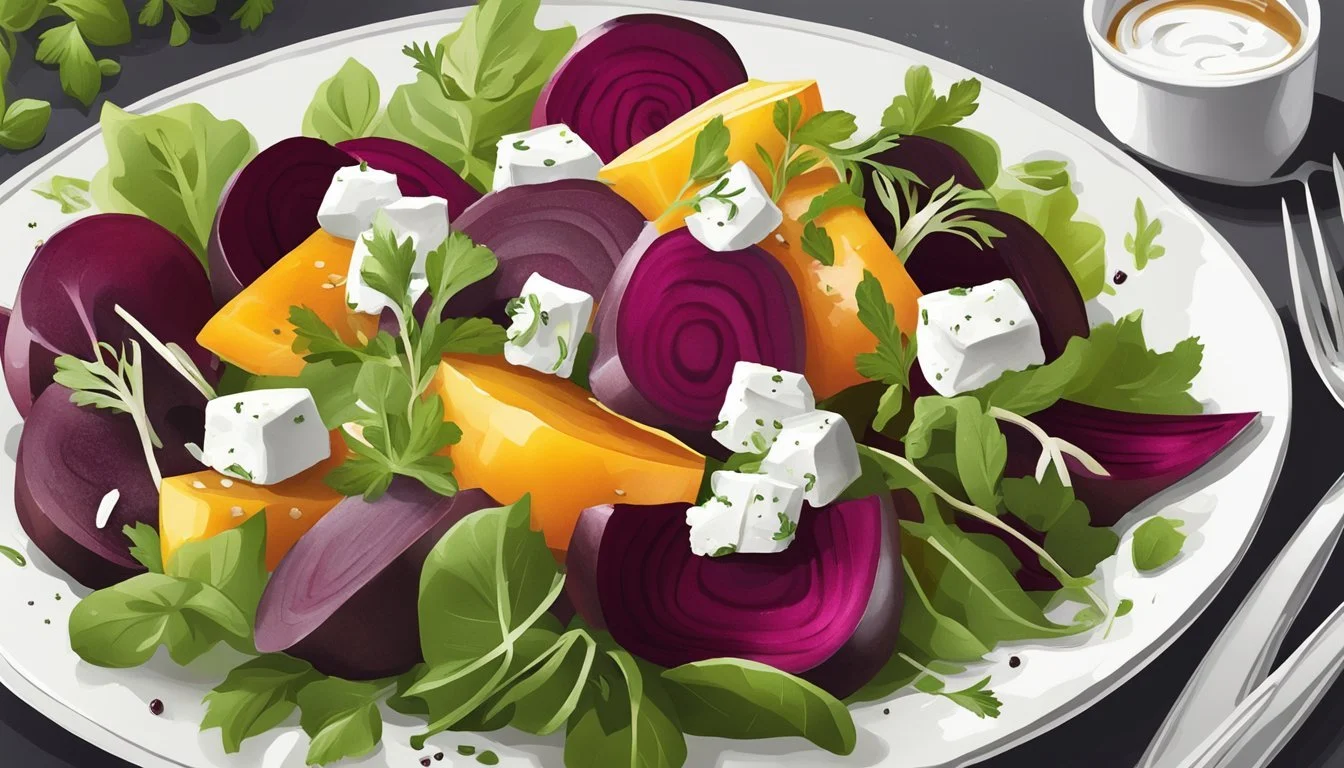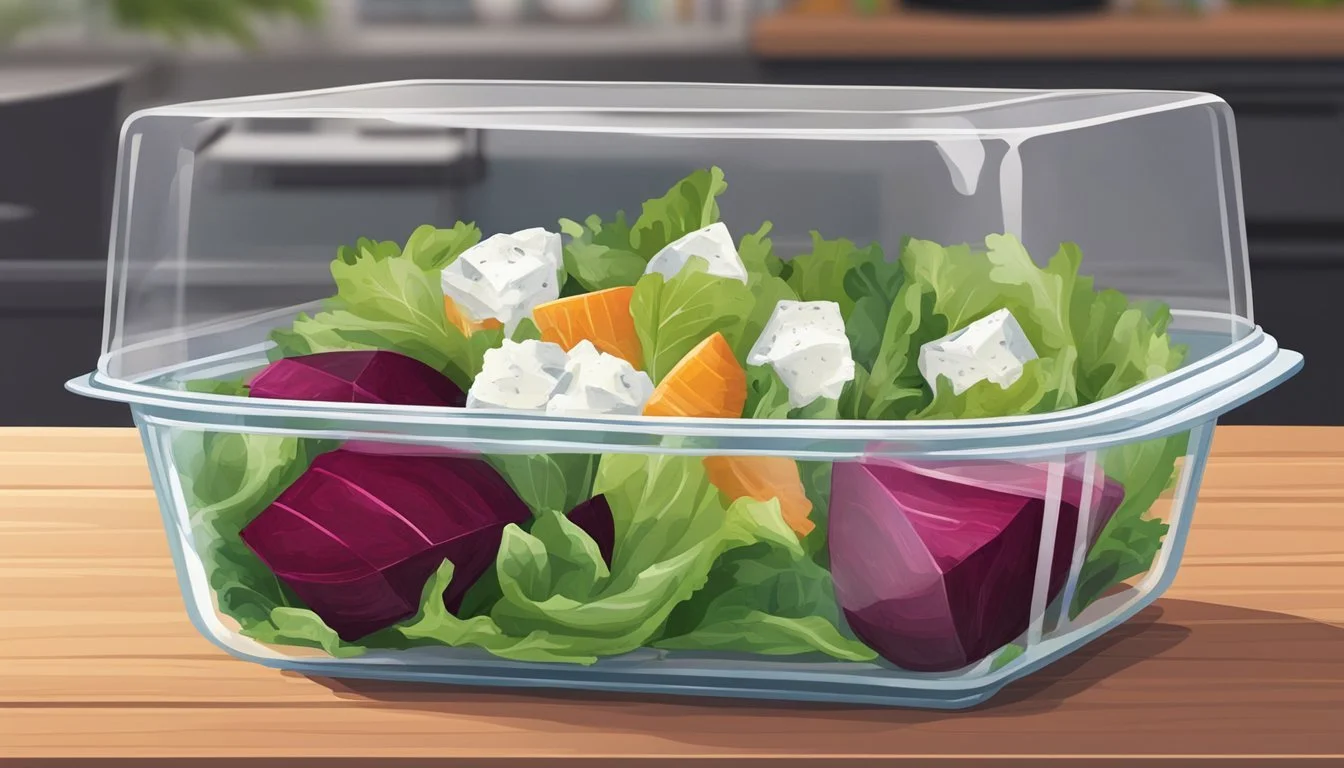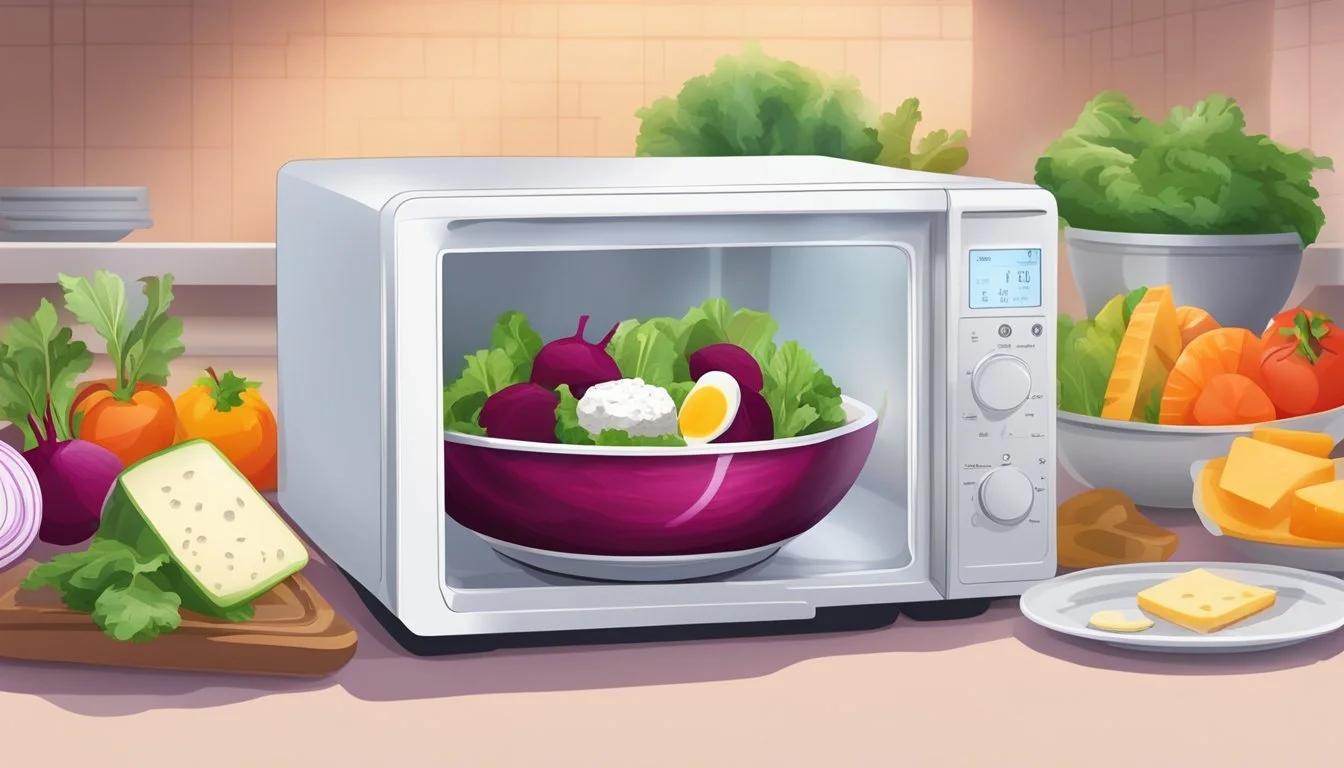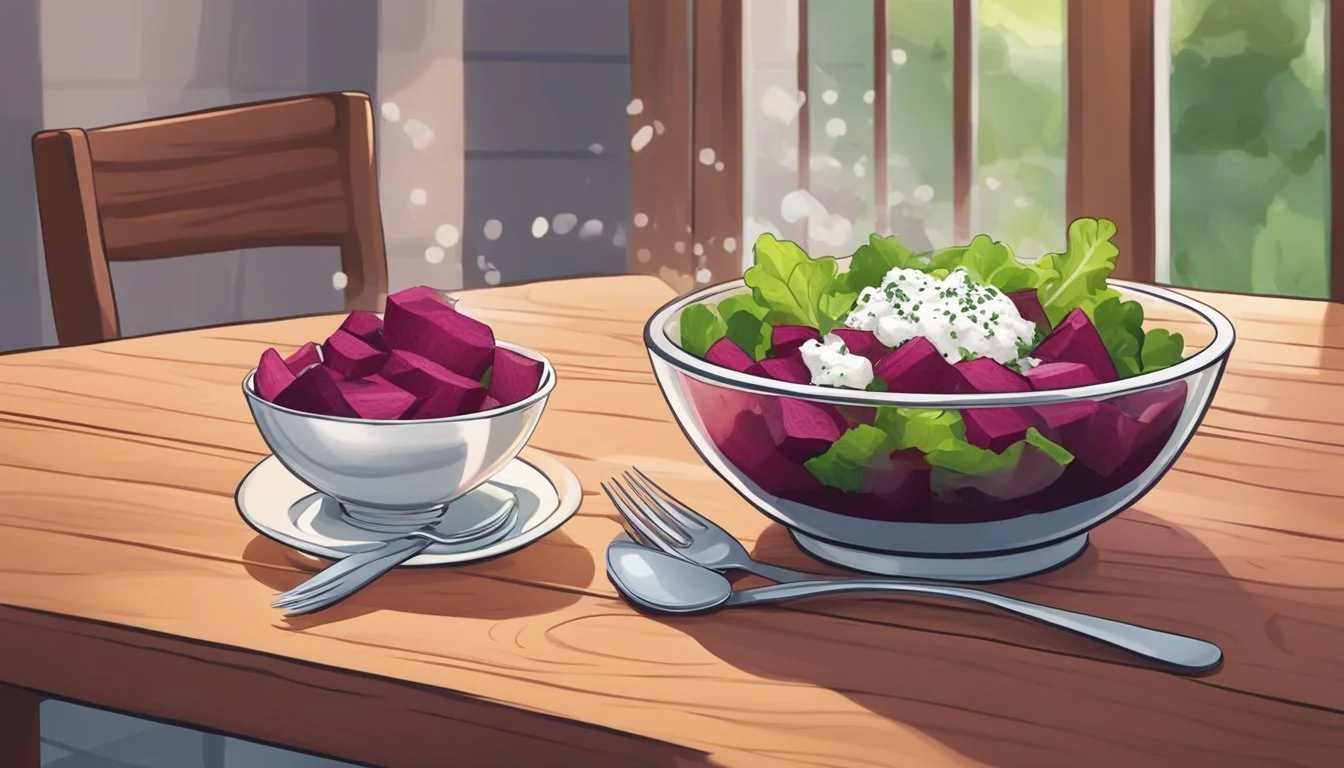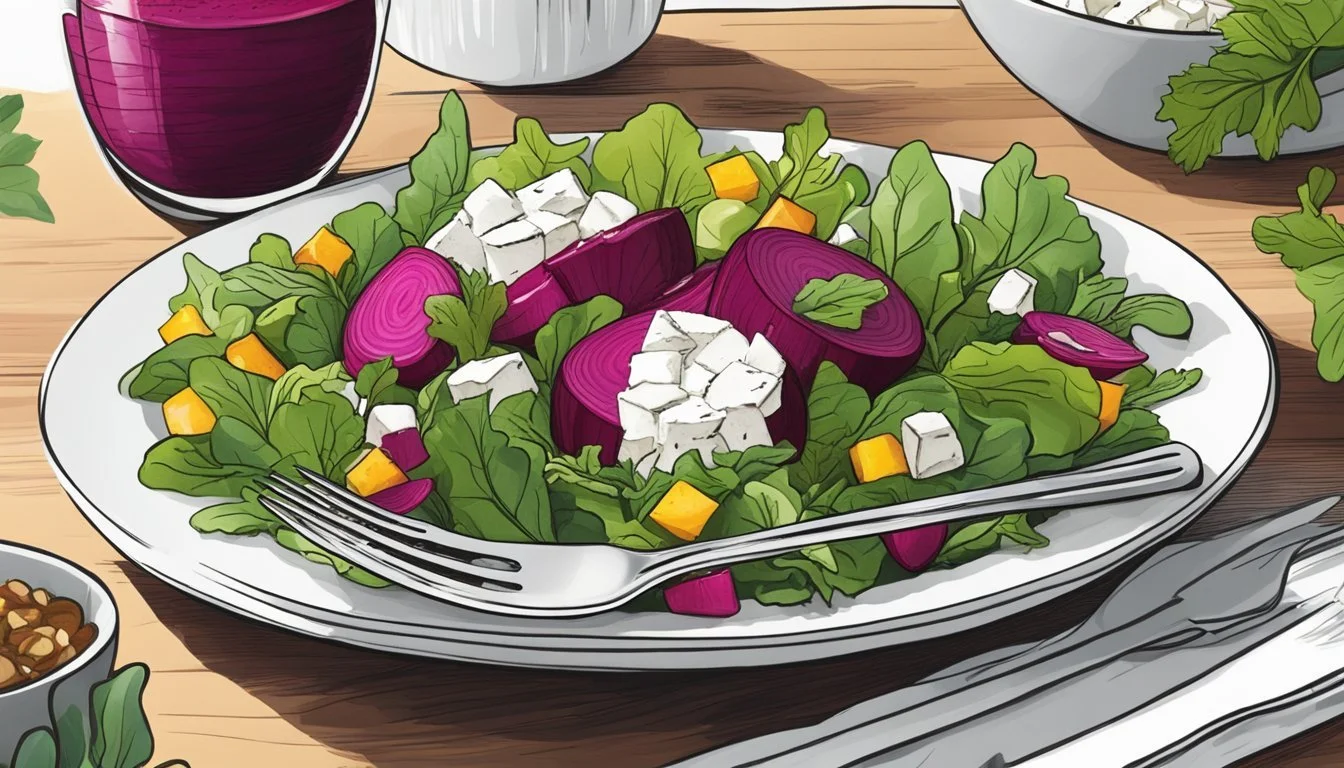Best Way to Reheat Beet and Goat Cheese Salad While Maintaining Freshness
A beet and goat cheese salad is a vibrant and flavorful dish that combines the earthy sweetness of roasted beets with the tangy creaminess of goat cheese. This dish is often enjoyed for its contrast of warm beets with cool, fresh greens, and the delicate balance of textures and flavors. However, when it comes to reheating leftovers, preserving the salad's freshness can be a challenge. The key is to gently warm the beets without causing the greens to wilt and ensuring that the goat cheese retains its rich texture.
The best method involves separating the components of the salad before reheating. Since the goat cheese and any leafy greens or fresh elements should not be subjected to heat, they are set aside. The focus is on reheating the beets, which can withstand the warmth and can be restored close to their original state with the right approach. Gently reheating the beets in a way that maintains their texture and sweetness ensures that they can be mixed back into the salad, revived and ready to complement the cool freshness of the other components.
Reheating should be done strategically to ensure that the essence of the salad is not lost. Careful attention to temperature and timing can help replicate the fresh out-of-the-oven feel for the beets without compromising the integrity of the entire dish. It is a delicate dance to preserve the integrity of each element of the salad, but with the proper technique, it's possible to enjoy a beet and goat cheese salad that tastes as good as when it was first prepared.
Understanding Beet and Goat Cheese Salad
Beet and goat cheese salad is a popular dish known for its vibrant colors and balanced flavors. The salad typically combines roasted or boiled beets with creamy goat cheese, adding both texture and a tangy taste to the dish.
Beets are a central component and bring a sweet and earthy flavor to the salad. They are rich in fiber, potassium, vitamin C, and iron, contributing to the nutritional value of the meal. Beets can be prepared in various ways, such as roasting to enhance their natural sweetness or boiling for a softer texture.
Goat cheese provides a creamy contrast to the beets. Its soft texture and distinct flavor pair exceptionally well with the natural sweetness of the beets. This cheese is also valued for its nutrient content, including essential proteins and fats.
In composing the recipe, one typically begins by preparing the beets, followed by assembling the salad with layers or a mixture of beets, goat cheese, and greens. Additional ingredients such as nuts or onions can be included for extra flavor and crunch.
A typical beet salad can be served as a standalone meal or as a complementary side dish. It is appreciated not only for its pleasing taste but also for the variety of nutrients it provides. This includes dietary fiber, which promotes digestive health, and other essential minerals and vitamins that support overall well-being.
When creating or serving beet and goat cheese salad, it's essential to maintain the balance between the sweetness of beets and the sharpness of the goat cheese, ensuring a harmonious blend of flavors and textures.
Preparation and Storage Tips
Ensuring the freshness and flavor of a beet and goat cheese salad depend heavily on the quality of its ingredients and how they are stored both before and after preparation. Here are the specifics on how to select, prepare, and store the components of this vibrant salad.
Beet Selection and Preparation
For the most flavorful salad, one should choose firm, smooth-skinned beets that are free from blemishes. Roasting beets enhances their sweet flavor, a balance that complements the tartness of goat cheese. Before storing, beets should be allowed to cool completely. They can be prepared ahead and stored in the refrigerator for up to 5 days. To store, place the roasted beets in an airtight container and drizzle them with a small amount of olive oil to maintain their moisture.
Goat Cheese Varieties and Handling
When selecting goat cheese for the salad, opting for a fresh, creamy variety will provide a pleasant textural contrast to the beets. To handle goat cheese properly, it should be kept refrigerated until serving. For ease of use, one might consider crumbling the goat cheese ahead of time and storing it in a separate airtight container in the refrigerator.
Salad Storage Techniques
The best practice for storing a beet and goat cheese salad to preserve its freshness involves managing the vinaigrette. Dressings should always be stored separately to prevent the salad greens from wilting. For make-ahead convenience, the dressing can be stored in a jar with a tight-fitting lid and then shaken or whisked before being applied. When refrigerating the assembled salad without the dressing, make sure to use an airtight container to maintain the quality. Leftover salad should be consumed within 3 days for optimal freshness.
Reheating Methodologies
When reheating beet and goat cheese salad, the primary goals are to warm the beets effectively while preserving the salad's freshness and maintaining the desirable textures, particularly the crunch of any toasted pine nuts.
Using the Oven
For the beets in a beet and goat cheese salad, the oven is an efficient method to reheat them while maintaining their texture. They recommend preheating the oven to 375°F (190°C) and preparing a baking sheet with aluminum foil for easy cleanup. Spread the beets out on the sheet, ensuring they are not overcrowded to preserve their texture. Drizzle with olive oil and season as desired. Cook time will vary based on the size, but typically 15-20 minutes should suffice.
Prep Time: Approx. 5 minutes
Cook Time: 15-20 minutes
Oven Temp: 375°F (190°C)
To preserve the integrity and crunch of any accompanying toasted pine nuts, it is essential to avoid reheating them with the beets. Instead, they should be added after the beets have been reheated to maintain their texture.
Alternative Reheating Techniques
If an oven is not available, other reheating methods can be employed, although they may not provide the same uniform heat as an oven. To maintain the dish's texture, the use of a skillet on a low to medium heat can warm the beets. A tight-fitting lid can help in creating a gentle steam that brings the beets up to temperature without drying them out or overheating the delicate greens and cheese.
Method: Skillet on low-medium heat
Cover: Use a lid for gentle steam
Attention: Frequently stir to ensure even warming
For the goat cheese salad component, it's best served at room temperature to maintain its freshness and avoid melting the cheese. If the salad contains elements like greens or dressings, they should never be reheated; instead, mix these with the warmed beets just before serving.
Maintaining Freshness and Flavor
When reheating beet and goat cheese salad, the freshness and flavor are paramount. It's essential to approach the reheating process mindfully to ensure that the delicate taste and texture of the beets and goat cheese remain intact.
Dressing Application
For a beet and goat cheese salad, the dressing can dramatically affect its freshness. To preserve the salad's integrity upon reheating:
Dressing Separation: Keep the dressing separate until just before serving. Dressings made with extra virgin olive oil, balsamic vinegar, honey, and mustard should be stored in an airtight container.
Gentle Reapplication: Before serving, drizzle the dressing lightly. If it’s a lemon vinaigrette, its zesty flavor can add freshness, but too much can overpower the beets and cheese.
Ingredient Integration
Effective integration of ingredients should be considered when reheating beet salad to maintain the complementary flavors.
Beets: Whether roasted or boiled, they should be reheated gently, with a sprinkle of salt and pepper to enhance their natural sweetness.
Goat Cheese: Should not be reheated; add it to the beets after they are warmed to preserve texture.
Herbs: If incorporated, like parsley or thyme, they should be fresh and added after reheating to retain their vibrant flavors.
Enhancing Your Salad
When reheating beet and goat cheese salad, one can enrich both its nutritional content and sensory appeal by adding a variety of ingredients.
Adding Nutritional Value
To boost the nutritional value of a beet and goat cheese salad, consider incorporating fruits such as slices of apple or pear for added vitamins and fiber. One can also sprinkle in some nuts—walnuts, pine nuts, pecans, or pistachios—all of which are excellent sources of healthy fats and protein. For a vegan option, replacing goat cheese with avocado provides a creamy texture while contributing heart-healthy monounsaturated fats.
Incorporating Texture Variants
Texture plays a crucial role in the enjoyment of a salad. By including different textures, the salad becomes a more complex and satisfying dish.
Crunch: Add a handful of toasted nuts like walnuts or pistachios to introduce a delightful crunch.
Creaminess: Avocado chunks or a vegan cheese alternative can lend a smooth, creamy contrast to the firm beets.
Chewiness: For some chewy elements, consider tossing in some dried fruit or roasted seeds.
To elevate the experience further, one might drizzle a vinaigrette over the salad just before serving; a simple mixture of balsamic vinegar, olive oil, and mustard can enhance the flavors without overwhelming them.
Salad Pairings and Serving Suggestions
Pairing the right components with Beet and Goat Cheese Salad enhances the meal's flavor and nutritional value. Choosing appropriate proteins and vegetarian alternatives can provide a well-rounded and satisfying dining experience.
Proteins to Complement the Salad
A Beet and Goat Cheese Salad pairs excellently with grilled chicken or baked salmon. The lightness of chicken and the rich, oily texture of salmon complement the earthiness of beets and the creamy tang of goat cheese.
Grilled Chicken: A lean, healthy option that can be seasoned to match the salad's profile.
Steak: Opt for a medium-rare steak to add a savory richness that contrasts nicely with the salad's brightness.
Vegan and Vegetarian Alternatives
Vegetarians can relish the salad with gluten-free and dairy-free options while ensuring a balanced meal.
Mixed Greens: A base of fresh mixed greens adds volume and a variety of textures.
Pear and Orange Segments: Fresh pear slices or orange segments introduce a sweet and fruity element that enhances the overall flavor of the salad.
Radish: Thinly sliced radishes offer a crisp, peppery bite, acting as a perfect counterpoint to the sweetness of the beetroot.
By thoughtfully selecting proteins and vegetarian options, one can create a meal that is both nutritionally robust and delightful to the palate.
Dietary Considerations
When reheating a beet and goat cheese salad, one must consider various dietary preferences and restrictions. For vegans, substituting goat cheese with a plant-based cheese alternative is crucial, ensuring the salad aligns with a diet free of animal products. Additionally, one could use nuts such as walnuts or almonds to add a crunchy texture, although this should be clearly communicated for those with nut allergies.
For individuals following a gluten-free diet, beets and goat cheese are naturally free from gluten. However, care should be taken to avoid cross-contamination with gluten-containing ingredients during preparation and reheating.
Dairy-Free Adaptation
Replace goat cheese with dairy-free cheese alternatives or omit it altogether.
Those concerned with maintaining the nutrients in their beet and goat cheese salad should consider gentle reheating methods to preserve the vitamins and minerals. Beets are rich in fiber, folate (vitamin B9), manganese, potassium, iron, and vitamin C. Consume the salad cold or at room temperature to retain these essential nutrients.
Nutritional Content
Fiber: Prominent in both beets and kale.
Vitamins: Kale is high in vitamins A, K, C, and B6.
Minerals: Beets contain manganese and potassium.
In the case of a roasted beet salad, reheating should be done carefully to avoid sogginess. As for a kale salad, it's preferable not to reheat the kale to maintain its crisp texture and nutritional value. Any additions, such as dressings or vinaigrettes, should be kept separate until right before serving to avoid a salad that's wilted or compromised in freshness.
Conclusion
Reheating a beet and goat cheese salad can be challenging, as it involves a delicate balance of maintaining freshness and ensuring that the ingredients do not become overcooked. For the best results, one should reheat components selectively:
Beets:
Should be warmed separately. Zip them through a microwave for 30 seconds or until warm but not hot.
Alternatively, they can be quickly flashed in the oven at 350°F for a few minutes.
Goat Cheese:
Best served at room temperature.
Remove from the refrigerator ahead of time to allow the cheese to soften.
For dinner parties, presenting a beet and goat cheese salad requires maintaining the integrity of its flavor and texture. The components of the salad may be prepared ahead of time; however, assembly should be done just before serving to ensure peak freshness and to prevent sogginess.
Beet recipes, in general, are vibrant and full of texture, and reheating should aim to preserve these qualities. If the salad has been previously tossed in dressing, a quick refresh with a drizzle of olive oil or a squeeze of lemon can reinvigorate the dish.
In conclusion, careful reheating and proper handling of ingredients are imperative for the beet and goat cheese salad to remain a delightful and elegant dish that is perfect for any dinner occasion.


